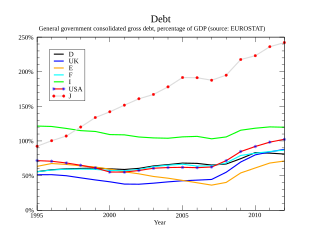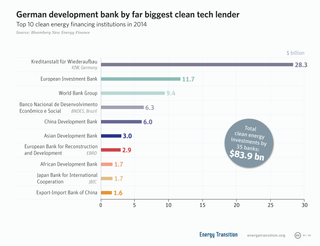Related Research Articles

The International Bank for Reconstruction and Development (IBRD) is an international financial institution, established in 1944 and headquartered in Washington, D.C., United States, that is the lending arm of World Bank Group. The IBRD offers loans to middle-income developing countries. The IBRD is the first of five member institutions that compose the World Bank Group. The initial mission of the IBRD in 1944, was to finance the reconstruction of European nations devastated by World War II. The IBRD and its concessional lending arm, the International Development Association (IDA), are collectively known as the World Bank as they share the same leadership and staff.

The International Finance Corporation (IFC) is an international financial institution that offers investment, advisory, and asset-management services to encourage private-sector development in less developed countries. The IFC is a member of the World Bank Group and is headquartered in Washington, D.C. in the United States.

A capital market is a financial market in which long-term debt or equity-backed securities are bought and sold. Capital markets channel the wealth of savers to those who can put it to long-term productive use, such as companies or governments making long-term investments. Financial regulators like Securities and Exchange Board of India (SEBI), Bank of England (BoE) and the U.S. Securities and Exchange Commission (SEC) oversee capital markets to protect investors against fraud, among other duties.

A security is a tradable financial asset. The term commonly refers to any form of financial instrument, but its legal definition varies by jurisdiction. In some countries and languages the term "security" is commonly used in day-to-day parlance to mean any form of financial instrument, even though the underlying legal and regulatory regime may not have such a broad definition. In some jurisdictions the term specifically excludes financial instruments other than equities and fixed income instruments. In some jurisdictions it includes some instruments that are close to equities and fixed income, e.g., equity warrants.

Natural capital is the world's stock of natural resources, which includes geology, soils, air, water and all living organisms. Some natural capital assets provide people with free goods and services, often called ecosystem services. Two of these underpin our economy and society, and thus make human life possible.
Environmental economics is a sub-field of economics concerned with environmental issues. It has become a widely studied subject due to growing environmental concerns in the twenty-first century. Environmental economics "undertakes theoretical or empirical studies of the economic effects of national or local environmental policies around the world.... Particular issues include the costs and benefits of alternative environmental policies to deal with air pollution, water quality, toxic substances, solid waste, and global warming."
The risk-free interest rate is the rate of return of a hypothetical investment with scheduled payment(s) over a fixed period of time that is assumed to meet all payment obligations.
In finance, a credit derivative refers to any one of "various instruments and techniques designed to separate and then transfer the credit risk" or the risk of an event of default of a corporate or sovereign borrower, transferring it to an entity other than the lender or debtholder.
The Nature Conservancy (TNC) is a charitable environmental organization, headquartered in Arlington, Virginia, United States.
The green economy is defined as economy that aims at making issues of reducing environmental risks and ecological scarcities, and that aims for sustainable development without degrading the environment. It is closely related with ecological economics, but has a more politically applied focus. The 2011 UNEP Green Economy Report argues "that to be green, an economy must not only be efficient, but also fair. Fairness implies recognizing global and country level equity dimensions, particularly in assuring a Just Transition to an economy that is low-carbon, resource efficient, and socially inclusive."

A collateralized debt obligation (CDO) is a type of structured asset-backed security (ABS). Originally developed as instruments for the corporate debt markets, after 2002 CDOs became vehicles for refinancing mortgage-backed securities (MBS). Like other private label securities backed by assets, a CDO can be thought of as a promise to pay investors in a prescribed sequence, based on the cash flow the CDO collects from the pool of bonds or other assets it owns. Distinctively, CDO credit risk is typically assessed based on a probability of default (PD) derived from ratings on those bonds or assets.
The following outline is provided as an overview of and topical guide to finance:
Debt-for-nature swaps are financial transactions in which a portion of a developing nation's foreign debt is forgiven in exchange for local investments in environmental conservation measures.
Payments for ecosystem services (PES), also known as payments for environmental services, are incentives offered to farmers or landowners in exchange for managing their land to provide some sort of ecological service. They have been defined as "a transparent system for the additional provision of environmental services through conditional payments to voluntary providers". These programmes promote the conservation of natural resources in the marketplace.
A non-banking financial institution (NBFI) or non-bank financial company (NBFC) is a financial institution that does not have a full banking license or is not supervised by a national or international banking regulatory agency. NBFC facilitate bank-related financial services, such as investment, risk pooling, contractual savings, and market brokering. Examples of these include insurance firms, pawn shops, cashier's check issuers, check cashing locations, payday lending, currency exchanges, and microloan organizations. Alan Greenspan has identified the role of NBFIs in strengthening an economy, as they provide "multiple alternatives to transform an economy's savings into capital investment which act as backup facilities should the primary form of intermediation fail."
Climate bonds are fixed-income financial instruments (bonds) that have positive environmental and/or climate benefits. They follow the Green Bond Principles stated by the International Capital Market Association (ICMA), and the proceeds from the issuance of which are to be used for the pre-specified types of projects.
Securitization is the financial practice of pooling various types of contractual debt such as residential mortgages, commercial mortgages, auto loans or credit card debt obligations and selling their related cash flows to third party investors as securities, which may be described as bonds, pass-through securities, or collateralized debt obligations (CDOs). Investors are repaid from the principal and interest cash flows collected from the underlying debt and redistributed through the capital structure of the new financing. Securities backed by mortgage receivables are called mortgage-backed securities (MBS), while those backed by other types of receivables are asset-backed securities (ABS).
Forest Trends is a non-profit organization founded in 1998 and based in Washington, DC that connects with economic tools and incentives for maintaining ecosystems. Its mission is four-fold: to expand the value of forests to society, to promote sustainable forest management and conservation by creating and capturing market values for ecosystem services, to support innovative projects and companies that are developing these markets and to enhance the livelihoods of local communities living in and around those forests.

Debt crisis is a situation in which a government loses the ability of paying back its governmental debt. When the expenditures of a government are more than its tax revenues for a prolonged period, the government may enter into a debt crisis. Various forms of governments finance their expenditures primarily by raising money through taxation. When tax revenues are insufficient, the government can make up the difference by issuing debt.

Climate finance is “finance that aims at reducing emissions, and enhancing sinks of greenhouse gases and aims at reducing vulnerability of, and maintaining and increasing the resilience of, human and ecological systems to negative climate change impacts”, as defined by the United Nations Framework Convention on Climate Change (UNFCCC) Standing Committee on Finance. The term has been used in a narrow sense to refer to transfers of public resources from developed to developing countries, in light of their UN Climate Convention obligations to provide "new and additional financial resources", and in a wider sense to refer to all financial flows relating to climate change mitigation and adaptation.
References
- 1 2 Clark, Story (2007). A Field Guide to Conservation Finance. p. xv. ISBN 9781597267588.
- ↑ "Overview". Conservation Finance Network. Archived from the original on 2 August 2013. Retrieved 3 July 2013.
- ↑ Huwyler, Fabian; Kaeppeli, Juerg; Serafimova, Katharina; Swanson, Eric; Tobin, John. "Making Conservation Finance Investable". Stanford Social Innovation Review. Stanford University. Retrieved 28 September 2015.
- ↑ Schuyler, Kevin W. (2005). "Expanding the Frontiers of Conservation Finance". From Walden to Wall Street: Frontiers of Conservation Finance. p. 110. ISBN 9781597269193.
- ↑ Schuyler, Kevin W. (2005). "Expanding the Frontiers of Conservation Finance". In James N. Levitt (ed.). From Walden to Wall Street: Frontiers of Conservation Finance. p. 111. ISBN 9781597269193.
- ↑ Schuyler, Kevin W. (2005). "Expanding the Frontiers of Conservation Finance". In James N. Levitt (ed.). From Walden to Wall Street: Frontiers of Conservation Finance. pp. 110–111. ISBN 9781597269193.
- ↑ Resor, James. "Debt-for-Nature Swaps: A Decade of Experience and New Directions for the Future". FAO Corporate Document Repository. Food And Agriculture Organization of the United Nations. Retrieved 23 October 2015.
- ↑ "Debt for Nature Swaps" (PDF). Convention on Biological Diversity. Convention on Biological Diversity. Retrieved 20 November 2015.
- 1 2 3 Resor, James. "Debt-for-Nature Swaps: A Decade of Experience and New Directions for the Future". FAO Corporate Document Repository. Food and Agriculture Organization of the United Nations. Retrieved 23 October 2015.
- ↑ Resor, James. "Debt-for Nature Swaps: A Decade of Experience and New Directions for the Future". FAO Corporate Document Repository. Food and Agriculture Organization for the United Nations. Retrieved 23 October 2015.
- 1 2 "Conserving Biodiversity and Forests". USAID. United States Agency for International Development. Retrieved 23 October 2015.
- ↑ "Conserving Biodiversity and Forests". USAID. U.S. Agency for International Development. Retrieved 23 October 2015.
- 1 2 3 Patel, Shilpa. "Climate Change and the Private Sector" (PDF). United States Institute of Peace. International Finance Corporation. Retrieved 20 November 2015.
- ↑ "Payments for Ecosystem Services Getting Started: A Primer" (PDF). UNEP. United Nations Environment Programme. Retrieved 11 December 2015.
- 1 2 3 4 "Payments for Ecosystem Services Getting Started: A Primer" (PDF). UNEP. United Nations Environmental Programme. Retrieved 11 December 2015.
- 1 2 3 "Markets and Payments for Environmental Services". IIED. International Institute for Environment and Development. Retrieved 11 December 2015.
- ↑ "Payments for Ecossytem Services Getting Started: A Primer" (PDF). UNEP. United Nations Environmental Programme. Retrieved 11 December 2015.
- 1 2 3 4 "Green Bonds Attract Private Sector Climate Finance". The World Bank. The World Bank Group. Retrieved 11 December 2015.
- ↑ "Proposition H - the Campaign for Solar Neighborhoods" (PDF).
- ↑ "San Francisco Ordinance establishing a Community Choice Aggregation Program to allow San Francisco to aggregate the electrical load of San Francisco electricity consumers and to accelerate renewable energy, conservation and energy efficiency" (PDF).
